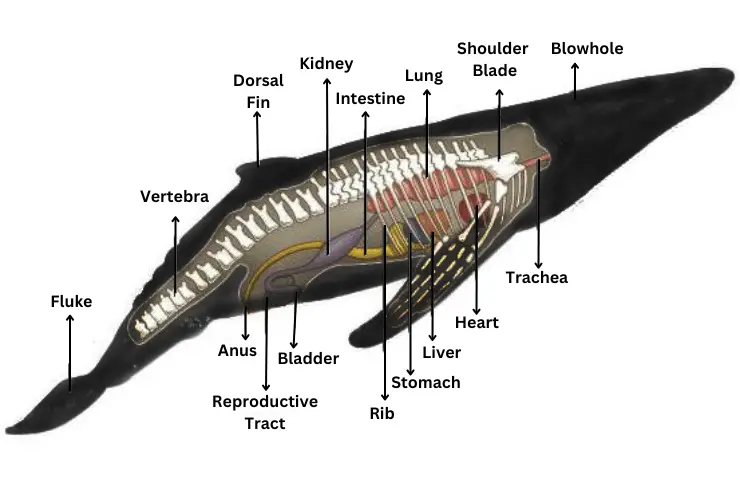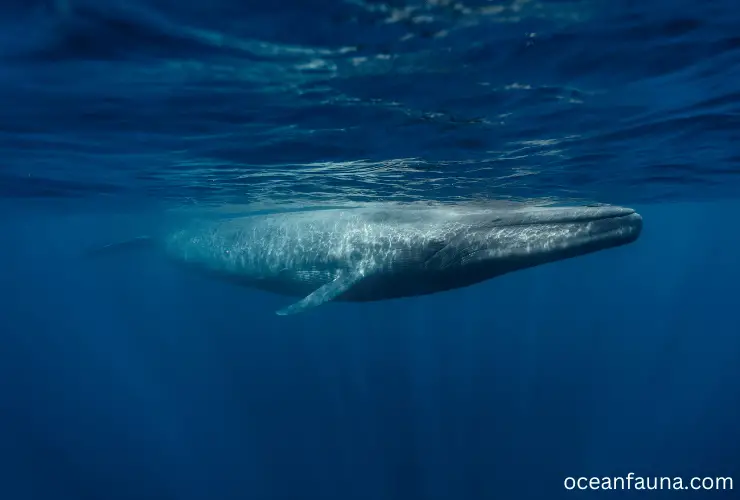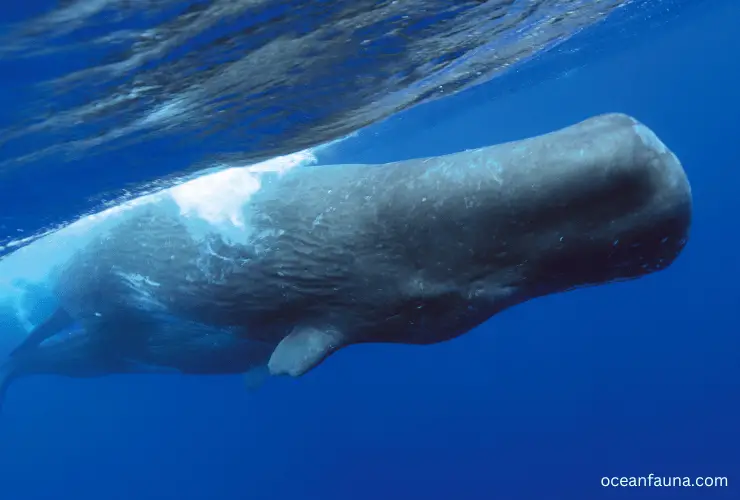How do whales manage to swim and float underwater? Do whales have swim bladders? Well, whales don’t have any swim bladders. Instead, their bodies are composed of a specialized type of fat known as blubber.
This fat is crucial in buoyancy, allowing whales to float and swim effortlessly. In contrast, swim bladders are gas-filled organs typically found in bony fish species, aiding them in controlling their buoyancy within the water.
In this blog, I will discuss the whale’s blubber and how it helps them swim and survive underwater.
What Is Whale Blubber?
Whale blubber, a complex and vital tissue layer, lies beneath the skin of these large marine mammals. Blubber, composed of the outer epidermis, the cushioning dermis, and the subcutaneous tissue that contains fat cells, performs several key functions for whales.

One key function of whale blubber is insulation from the cold of their aquatic environment. Its thickness and density keep the whale warm, even in the deep, frigid ocean. Blubber also stores energy in lipids, which the whale can use during food shortages.
Blubber’s thickness varies with the whale’s species, age, sex, and habitat. For example, Arctic whales have thicker blubber for winter protection, while blubber tends to be thinner in warmer waters. Different whale species also have varying blubber thicknesses.
The anatomy of whale blubber is designed for high functionality. The outer epidermis layer protects from external elements, and the dermis layer supports and prevents damage. The subcutaneous layer, home to adipose tissue, buoyancy aids. This helps the whale swim easily and store energy.
Do Whales Need a Swim Bladder?
Unlike bony fish, whales don’t need a swim bladder for buoyancy. This is mainly because whales and fish have different body structures and lifestyles. Fish use their swim bladder to control buoyancy: they fill it with gas to rise and empty it to sink in the water.
In contrast, whales are mammals with lungs instead of swim bladders. They breathe air and control buoyancy differently from fish. To dive, whales exhale, reducing buoyancy. Their heavy skeletons then help them descend. To surface, they inhale, filling their lungs with air to increase buoyancy and rise.
Additionally, whales’ blubber assists in buoyancy control. The fat’s lipid cells are lighter than water, adding to their buoyancy. This helps whales float effortlessly, without the need to swim constantly to stay afloat.
It’s fascinating how nature evolves different mechanisms for species to adapt to their environments. Whales’ lack of a swim bladder is a prime example, showing their unique adaptation to ocean life.
How Do Whales Swim?

Whales swim uniquely and efficiently, known as ‘uniform swimming.’ This swimming method involves the tail fin or fluke and the tail stock moving oscillating. Unlike fish that move side-to-side, whales move their flukes up and down in vertical strokes to create thrust.
A wave of energy, created by the whale’s muscles, begins at the front and moves towards the tail. The strong muscles near the tail generate a lot of force, propelling the whale forward. This method is effective and saves energy, helping whales travel long distances.
The tail flukes are crucial in this process. They’re used for propulsion, steering, and stopping. The wide, horizontal flukes provide a large surface to push against the water. Their leading edge is thick and rounded for control, and the trailing edge is thin and flexible.
Whales also use long, slim pectoral flippers, similar to plane wings, for steering and stopping. These flippers help change direction, roll over, or stop.
A whale’s body is streamlined, which reduces drag. This helps the whale swim efficiently. The skin, smooth and covered with mucus, further reduces drag and allows easy movement through water.
How Do Whales Stay Buoyant?
Whales stay buoyant thanks to their specialized tissue called blubber. Blubber is less dense than seawater, creating buoyancy that helps whales float. This allows them to move gracefully in water with minimal effort.
Among marine mammals, right whales have the thickest blubber. The thick blubber is vital for survival in the freezing Arctic and Antarctic oceans. It provides warmth and buoyancy, crucial in such cold environments.
The fat acts as insulation and a natural life jacket, letting whales float easily in cold waters. This is especially important for newborn calves, helping them stay afloat while nursing.
The buoyancy from blubber offers several advantages. It saves energy, as whales don’t need to swim constantly to stay afloat. This is useful during rest or sleep, keeping them near the surface for easy air access.
Adaptive evolution has balanced their buoyancy and weight. This showcases how blubber’s unique properties help whales thrive in the ocean. These adaptations are a testament to the incredible resilience of these magnificent creatures in their marine habitats.
Similarities and Dissimilarities Between Swim Bladder and Blubber

Similarities Between Swim Bladder and Blubber
While the swim bladder and fat have different functions in different species, they share key similarities.
- The swim bladder and fat are crucial for buoyancy control, helping fish and whales navigate in water.
- The swim bladder in fish regulates buoyancy by adjusting gas content. Similarly, whale blubber, less dense than seawater, offers a natural upward force.
- Another common aspect lies in energy conservation. Whales float effortlessly, while fish adjust their depth without much energy use. This shows how both adaptations effectively conserve energy and assist with buoyancy in the aquatic environment.
Dissimilarities Between Swim Bladder and Blubber
Despite similarities, swim bladders in fish and blubber in whales have key differences due to their unique biological roles.
- The swim bladder is a gas-filled organ for buoyancy. In contrast, blubber is a fat layer under the skin for insulation and buoyancy control.
- In contrast to the swim bladder’s adjustable buoyancy, the fat’s buoyancy is stable, based on its density relative to water.
- Also, unlike the swim bladder, blubber is an energy reserve during food scarcity.
- Another key difference is thermal regulation. Blubber insulates whales from cold, a function the swim bladder doesn’t provide in fish.
- In some fish, the swim bladder aids in respiration, which is not a role of fat.
These differences between the swim bladder and blubber highlight the remarkable diversity of life. They show the unique ways species have evolved to adapt to their environments.
FAQs
How fast do whales swim?
On average, whales swim from 3 to 20 km/h. Some species can even reach speeds of 30-50 km/h for short bursts! For example, blue whales can zoom 50 km/h (31 mph) when having a great time with pals. Their typical speed is around 20 km/h (12 mph) when cruising. And when it’s time to eat, they slow down to a leisurely 5 km/h (3.1 mph).
How deep do whales swim?
It depends on how long they can hold their breath. The Cuvier’s beaked whale, the deepest-diving mammal can go down to depths of 2,992 meters (nearly 1.9 miles)! It has a record of holding its breath for 222 minutes.
Sperm whales can hold their breath for up to 90 minutes and swim up to 2250 meters deep.
However, most whales don’t dive that deep and stay within the top 100 meters (330 feet), where there is plenty of food.
Do all whales have blubber?
All whales have a layer of fat beneath their skin. However, the thickness of this blubber can vary among species and even among individuals of the same species. For instance, Bowhead whales possess the thickest blubber, measuring 17 to 19 inches (43 to 48 cm).
Conclusion
Hopefully, you are clear that whales don’t have swim bladders, even if they don’t need them. They have fat for buoyancy and insulation. If you have more queries regarding whales’ underwater lifestyle, you may ask in a comment.

